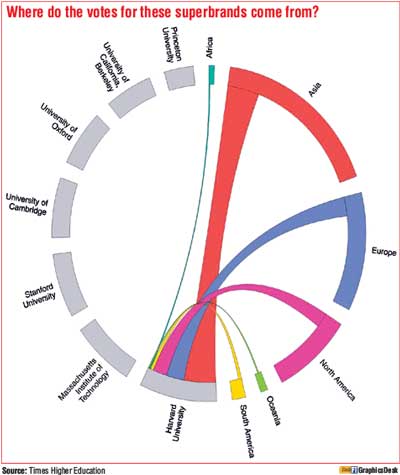Friday Dec 13, 2024
Friday Dec 13, 2024
Wednesday, 1 June 2016 16:26 - - {{hitsCtrl.values.hits}}


By Duncan Ross Recently, Times Higher Education launched the 2016 World Reputation Rankings. We surveyed more than 10,000 academics to understand the global opinion of university reputation. I’m not going to go into the methodology here, but if you’re interested, the highlights are: Our base population is academics who have published a paper within the Elsevier Scopus database We select randomly within this population We balance the responses by geography based on data on the number of researchers in a country We perform a secondary balance on broad subjects The full methodology is detailed here. As for the questions, they are fairly straightforward. We ask people to vote for up to 15 universities that are, in their opinion, the best universities for their field of expertise. We have a huge range of responses – including a vote (to my great joy) for the Antarctic Research Station. As far as I can tell that makes us the only survey to cover all seven continents.
The six top universities
One of the key features of the results is that there are six universities that clearly lead the world when it comes to their reputation:
Although the order has changed since we first started publishing the survey in 2011, the top six have dominated voting. Our  rankings editor, Phil Baty, has described these as the ‘university superbrands’, and that seems a reasonable description. So can we dig into the data a little more, and explore what it means to be a superbrand? When we look at the Harvard data as an example, the superbrands seem to get votes from everywhere: these brands are universal. Harvard actually gets more votes from Asia than it does from North America. But if we dig a little deeper some interesting differences appear. This chart shows the votes for teaching reputation from voters overall, in Europe and in North America. First, teaching gives us a somewhat different order to overall reputation. Harvard is still king, followed by four universities with fairly similar scores, then finally Berkeley. But when we break it down by the regions we see differences. Cambridge and Oxford do better in Europe, Oceania and Africa. In fact, Cambridge beats Harvard to the number one place in Europe and Oceania.
rankings editor, Phil Baty, has described these as the ‘university superbrands’, and that seems a reasonable description. So can we dig into the data a little more, and explore what it means to be a superbrand? When we look at the Harvard data as an example, the superbrands seem to get votes from everywhere: these brands are universal. Harvard actually gets more votes from Asia than it does from North America. But if we dig a little deeper some interesting differences appear. This chart shows the votes for teaching reputation from voters overall, in Europe and in North America. First, teaching gives us a somewhat different order to overall reputation. Harvard is still king, followed by four universities with fairly similar scores, then finally Berkeley. But when we break it down by the regions we see differences. Cambridge and Oxford do better in Europe, Oceania and Africa. In fact, Cambridge beats Harvard to the number one place in Europe and Oceania.
Now you might, reasonably, say that this is an outcome of colonialism – and certainly the votes in North America and Asia make up for this in the overall results. What do they look like in terms of subjects? Remember that I said that we balanced opinions by subject? Well, when we look at how strong the reputation of these superbrands is across the subject areas, we see some interesting differences.
First, here are our broad subject categories:
Let’s start with the big beast: Harvard. Looking at the data, Harvard does especially well when it comes to clinical reputation, but also does very well in business and life sciences. Its weakest areas (and let’s be clear, they are only relatively weak) are computer sciences, engineering and physical sciences. Now let’s look at two that are somewhat similar: MIT and Stanford. Unlike Harvard, their reputations are heavily engineering focused. As we might expect, MIT is a bit more engineering focused, Stanford gets more of a boost from Business. (Oh, and please note that these graphs aren’t to scale with each other – don’t compare this one with the Harvard one.) So far we’ve been exploring US institutions. Let’s hop back across the Atlantic and examine Oxford and Cambridge. If I could see similarities in reputation for MIT and Stanford, then when we look at Oxford and Cambridge we see almost identical shapes – to the extent that it’s tempting to think that some academics are actually voting for Oxbridge as a single entity (to the chagrin of some, including the Cambridge vice-chancellor). Here, arts and humanities, social sciences and physical sciences are much stronger. Perhaps worryingly for these two noble institutions is that the presence of the Saïd and Judge business schools doesn’t seem to have transferred into active reputation yet. The final one of our superbrands is Berkeley. And, if we ignore clinical and health (which is actually a specialism of other parts of the University of California system), then there is a strong argument to say that Berkeley is actually the most rounded of the six in terms of its reputation scores. What might these brands be worth? Now this is where it gets really interesting. How much is all this reputation worth? Conventional mechanisms for calculating brand value probably aren’t applicable for universities, but there can be little doubt that students and prospective students see the value in gaining a degree from one of these institutions. Can that be expressed in dollars? Probably, but that’s an analysis for another day.